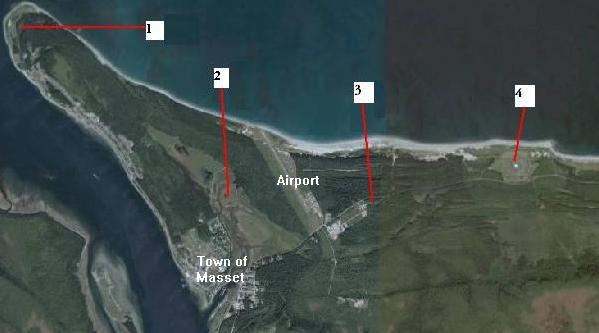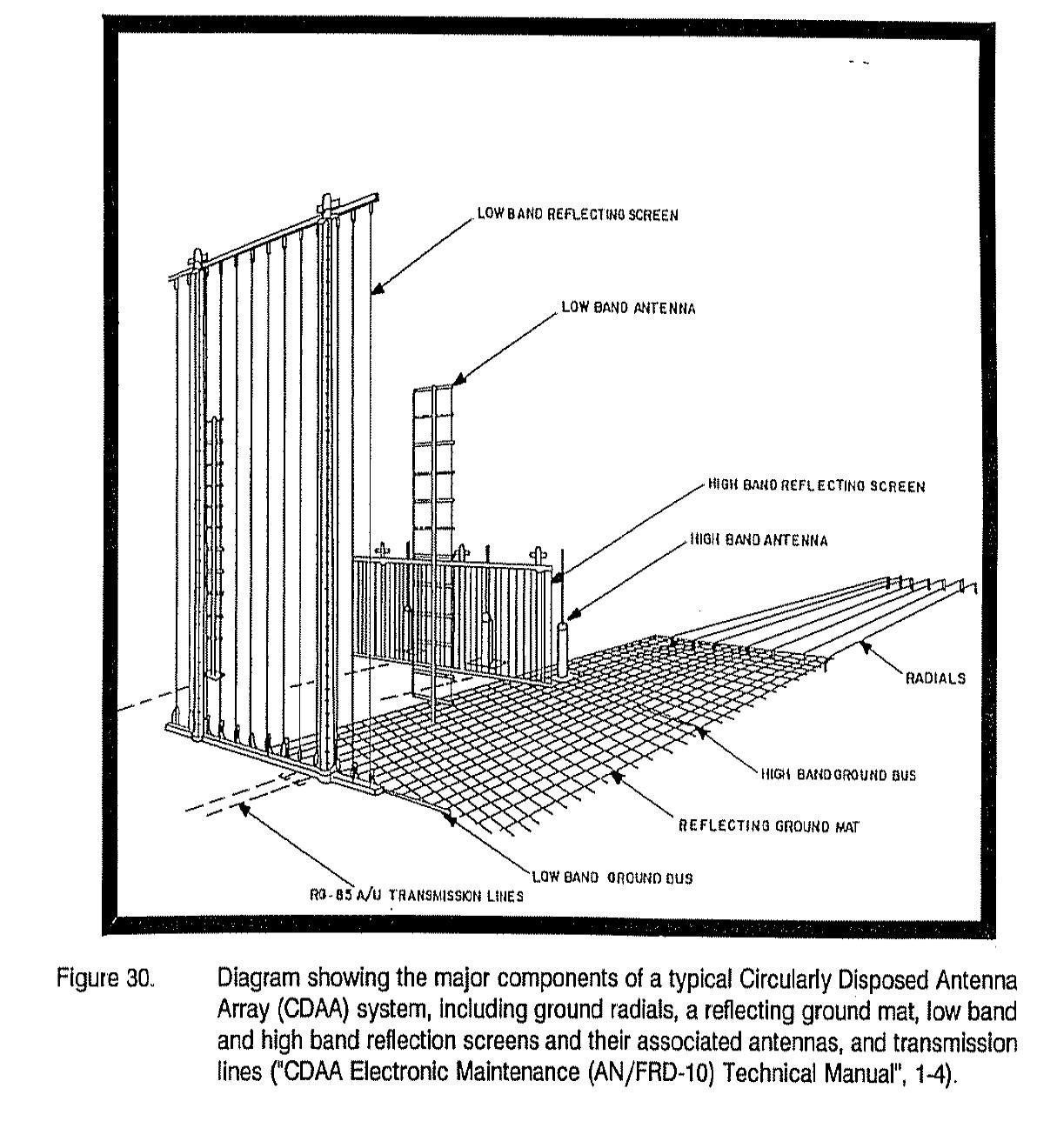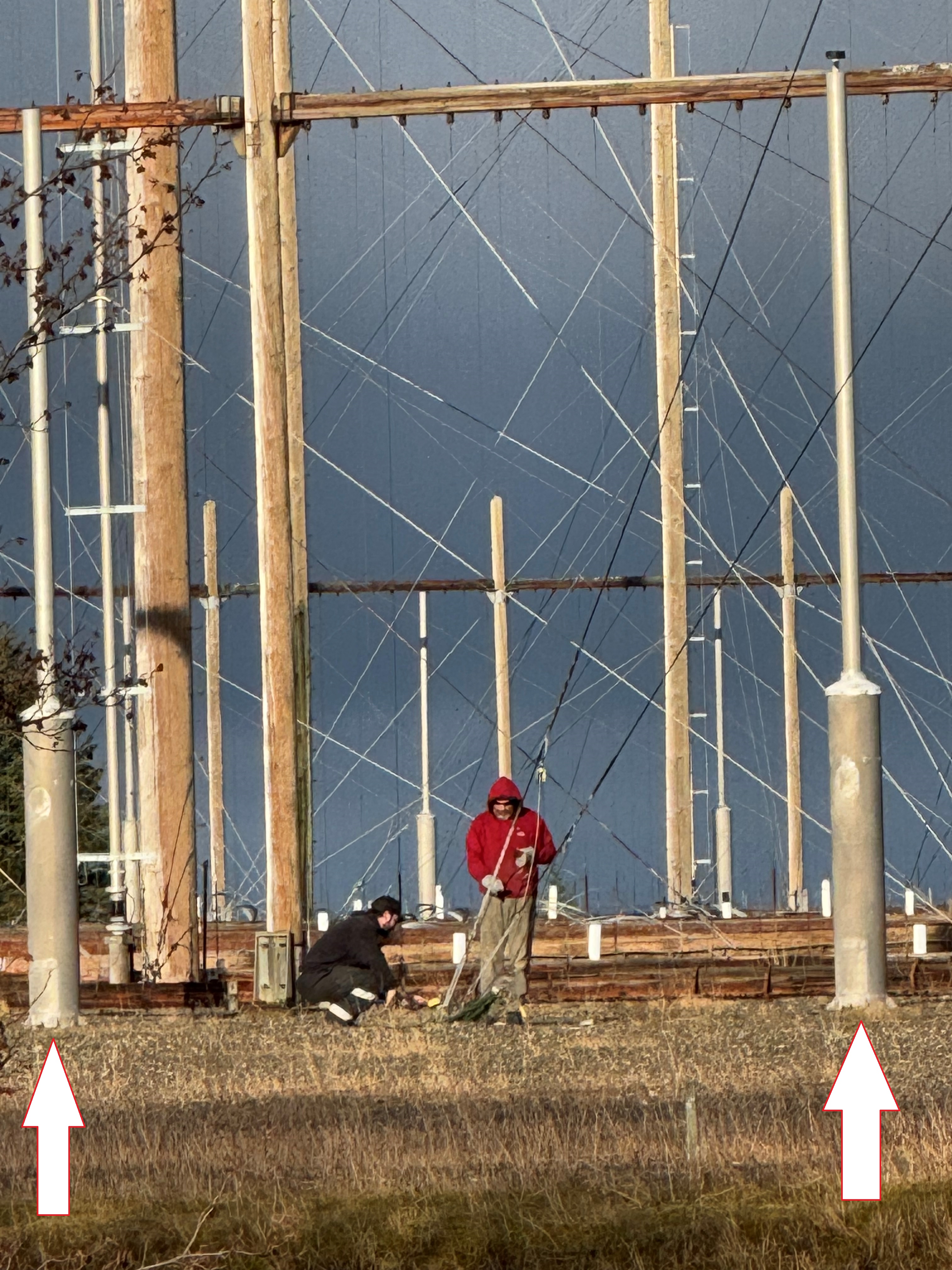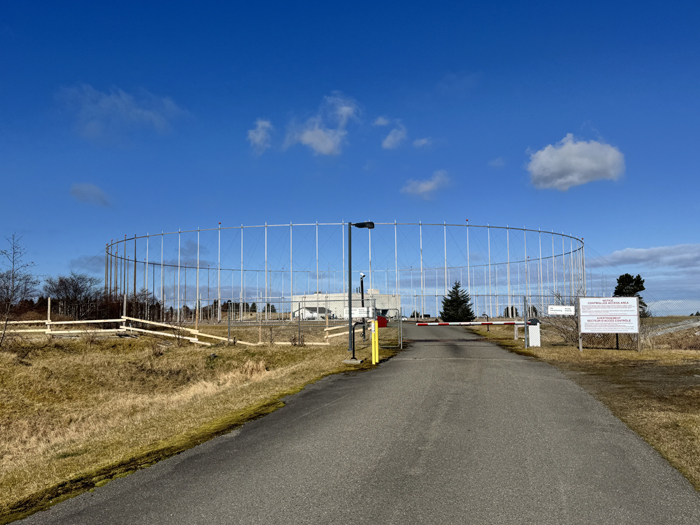HFDF OPERATIONS
1950's
In 1950, the RCN and the USN formally agreed to coordinate and standardize
HF/DF activities ashore.
This initiative resulted in the integration of all Canadian and US
stations into two networks which would provide mutual support for the common
objective of maritime warfare. On the East coast of North America, it was
called the Atlantic HFDF network and in the West it was known the Eastern
Pacific HFDF network or EASTPAC.
In the East, the Atlantic HFDF network was comprised of five RCN stations:
Coverdale, NB; Chimo (1949-52), Frobisher Bay, N.W.T.; Gander, Nfld; Bermuda
(1963-1966 only), Gloucester, Ont. plus ten USN stations.
Harry Brooks, a former USN net controller, provides some background
information on the organization of the Pacific HFDF Net. "In 1952, the
Pacific Net (PACNET) was one big net with Wahiawa3, Oahu, Hawaii
as the Net Control station. At that time, we used specific call signs assigned
to the net. Wahiawa was NIT. Sometime in 1953 or 1954, PACNET split into
EASTPAC and WESTPAC nets, with Skaggs Island as control station for EASTPAC
and Kami Seya, Japan as net control for WESTPAC. Call signs reverted to
the standard Navy system with Kami Seya becoming NDT, Wahiawa changing
to NPM, and Skaggs Island to NPG.
In July, 1956, Skaggs Island passed Net Control to Wahiawa so Skaggs
could install the first AN/GRD-6 DF system. I was sent to Wahiawa a net
control operator on temporary duty for 3 months. At that time, EASTPAC
consisted of:
Skaggs Island, California/NPG - Net Control
Imperial Beach, California /NPL
Bainbridge Island, Washington /NPC (closed 15 March 1953 - transferred
responsibilities to Marietta, WA).
Marietta WA, (Commissioned 15 April 1953 using NPC and later
NGO)
Masset, British Columbia /CFS
Cape Chiniak, Kodiak Island7., Alaska/NHB
Adak, Alaska/NUD
Wahiawa, Hawaii /NPM - Alternate Net Control
Midway Island./NQM (Midway was in both nets at one time) ".
Sam Stokes , KG6WYZ a former controller in both WESTPAC and EASTPAC
nets during the 1960's, remembers the following networks as summarized
in this table.
|
EASTPAC
|
WESTPAC
|
FUNCTION/COMMENT |
|
|
|
| Wahiawa, Hawaii |
-- |
Net Control |
| Skaggs Island, Calif. |
-- |
Alternate Net Control |
| Elmendorf AFB, Alaska |
-- |
|
| Marietta, Washington |
-- |
Closed 1972. Functions assumed by Masset |
| Imperial Beach, Calif. |
-- |
|
|
|
|
| -- |
San Miguel, Philippines |
Net Control |
| -- |
Guam |
Alternate Net Control |
| -- |
Adak, Alaska |
|
| -- |
Misawa, Japan |
|
| -- |
Kamisaya, Japan |
|
| -- |
Midway Island |
Midway was in both nets at one time. |
Al Grobmeier provides a list of frequencies from the U.S. Navy Frequency
Plan (JANAP 195) which could be used by the WESTPAC and EASTPAC HFDF nets.
During the 1950's, all net communications was on CW only, later moving
to Teletype. It is believed that all the USN stations transmitted reports
simultaneously on five frequencies but only Imperial Beach has been confirmed
to operate that way.
FLASH FREQUENCIES (kHz)
|
WESTPAC
|
|
EASTPAC
|
| Circuit |
Designator |
Frequency |
|
Circuit |
Designator |
Frequency |
| -- |
Alpha |
4045 |
|
CD |
Alpha |
4040 |
| -- |
Bravo |
8020 |
|
HJ |
Bravo |
8030 |
| -- |
Charlie |
12015 |
|
OK |
Charlie |
11563 |
| -- |
Delta |
16020 |
|
NM |
Delta |
15815 |
| -- |
Echo |
20025 |
|
FL |
Echo |
19660 |
| -- |
Foxtrot |
24415 |
|
YB |
Foxtrot |
24780 |
REPORTING FREQUENCIES (kHz)
|
WESTPAC
|
|
EASTPAC
|
| Circuit |
Designator |
Frequency |
|
Circuit |
Designator |
Frequency |
| -- |
Hotel |
4595 |
|
BY |
Hotel |
5915 |
| -- |
India |
7385 |
|
YG |
India |
7380 |
| -- |
Juliette |
12145 |
|
ZF |
Juliette |
11672.5 |
| -- |
Kilo |
15595 |
|
ML |
Kilo |
15990 |
| -- |
Lima |
17690 |
|
WV |
Lima |
19785 |
| -- |
Mike |
22740 |
|
LG |
Mike |
24685 |
In its simplest form, Masset operated in the following manner. When
a prospective target made an emission which was heard by the Control Center,
Control "flashed" the details of the emission (frequency and call sign)
to the stations of the network. The stations tuned in the signal, took
bearings then reported the bearing to Control. At Control, the bearings
were collated and a fix area established. By the time computers had been
introduced to help automate the process, the end was near for this method
of obtaining a bearing on a target.
EASTPAC used CW for both flash and reporting circuits which necessitated
the use of call signs. Around, 1960, the flash circuit went to plain uncovered.
RATT (radioteletype) using off-line crypto systems. Reporting continued
on CW until the Net shifted to the FRD-10. After the AN/FRD-10 came into
use, stations were referred to by location only.
Uncovered RATT was RATT sent in plain language. Covered RATT, on the
other hand used an on-line crypto system which permitted real-time encryption/decryption.
For the later Bullseye system use, the flash circuit was used the JASON
(KWT-37/KWR-37) crypto system, and later the KW-26
crypto system.
Sam also provides a glimpse into the equipment by USN PACNET stations.
"We used the appropriate sector of the antenna to receive a signal from
the distant stations in the net. There was an entire wall of AN/FRR-60
receivers5. for receiving each outstation in our net.
The output from the AN/FRR-60's went to a bay containing AN/FGC-606.
tone converters to demultiplex the incoming radioteletype (RATT) signal.
The signal then went through the KW-26 crypto gear where it was converted
to plain text and then into an internal circuit that went out into the
operating spaces.
All communications was by RATT, probably 99% of it encrypted. The only
time we would go "low" or "Red" would be if there were some sort of really
serious problem with the circuit. We would run a Fox test tape loop in
the clear for circuit testing purposes. And, of course, all teletype traffic
was routed using routing indicators that had no connection to the naval
radio call sign of the ship or station".
 |
|
Badge courtesy Joe Glockner
|
1960's
George Fraser recalls the transition period of the late 1960's at Masset.
"While I was the Operations Officer at CFS Bermuda, I was told I was a
prime candidate for an opening at CFS Masset which was being fitted with
AN/FRD10 CDAA technology. My training in Wide and Narrow Band Operations
(WBNB) at the NAVSECGRU (Naval Security Group) training school in Pensacola,
Florida and my current serving tour in CFS Bermuda was instrumental
in preparing me for my next move.
In June/July 1970, I was appointed to the unique positions of Ops Officer
CFS Ladner (for purposes of shutting it down) and at the same time
to act as Operations Officer at CFS Masset. There, I was to shut down the
"Old Site" and flash up the "New Site". Needless to say, I spent
the next few months commuting between Ladner and Masset while attending
to the transition at Masset.
What I remember of Masset was the outstanding "gung ho" attitude of
the SUPRAD personnel. For example, to bring up the new site operation,
NCO PAC gave us three weeks to shut down total operations at both sites.
This was the same time period that they had given all their USN stations
to convert to new WBNB operations. Due to the very positive attitude of
our personnel, we were able to accomplish the transition before the window.
CPO Keith MacDougall and his operations staff were at the Old
Site at the end of the "Zulu" day when the last Flash message was received.
Myself, CPO Rufus (Bob) King and CPO Don Tarabas were at the new site ready
and waiting. The USN assumed we were shutting down but the first Flash
of the new day came over and our operator at the new site responded with
a bearing. The Yanks were blown away! I took great pride over the years
in how positive our people were in making sure this was done without the
benefit of shutting down for the three week period.
Another memory about CFS Masset still grates me to this day. Being part
of the PAC (Eastern Pacific) HFDF Net and having supported the USN activities
in Vietnam and the launch up of the new and modernized PACNET, the USN
Chief of Naval Operations issued a medal which was awarded to every operations
person at every PACNET station including CFS Masset. Our Director of Supplementary
Radio Stations (DSRA) turned down the medal and denied it to our operators.
We had fifteen USN personnel serving at Masset at the time and they all
received the medal but our guys did not. I sent so many messages and letters
about this, that finally the Commander ordered me to desist (or else).
In any event, I have been able over the years, to accept the fact that
the SUPRAD personnel who served at this time at Masset had earned the medal
even if they couldn't wear it.
Most of Ladner's intercept positions were moved to Masset. Masset Operations
consisted of intercept, LRTS8. (Long Range Technical Search),
Wide Band and Narrow Band HFDF and several other positions. We were
manned by Canadian Forces personnel -- former RCN, RCCS (Royal Canadian
Corps of Signals) and RCAF tradesmen of the Communications Research and
Electronic Technician trades, as well as some civilian operators from Ladner,
British Royal Signal Corps personnel and USN Communications Technicians
(R and M Branches).
After two years, I was posted to CFS Alert as the Operations Officer.
On my return, I was again appointed Ops Officer of Masset but my appointment
to NAVSECGRU at Nebraska Ave., Washington was in and Masset's Commanding
Officer, Al Brockley asked me to come "down town" and do some special
projects before being posted out. It was a great tour with some of the
greatest people I ever served with".
1970's
The most prominent feature at Masset is the the Circularly Disposed
Antenna Array (CDAA) part of the AN/FRD-10 system which is sometimes referred
to as a Circularly Disposed Dipole Array (CDDA). It's major feature allows
the listener to electronically steer the beamwidth and alter the pattern
shape at will. Bearing accuracy is reported to be better than one-half
of a degree.
 |
| Masset's AN/FRD-10 installation. After this antenna was erected, there
was little use for any of the old equipment so all the obsolete antennas
were torn down and removed. (Photo courtesy Irv's Home Page) |
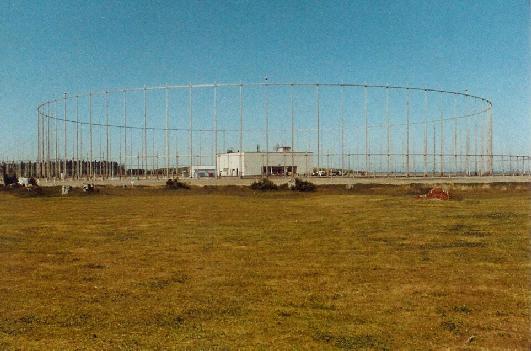 |
|
Another view of Masset's AN/FRD-10. The antenna is
made by RCA. (Photo by Jim Troyanek)
|
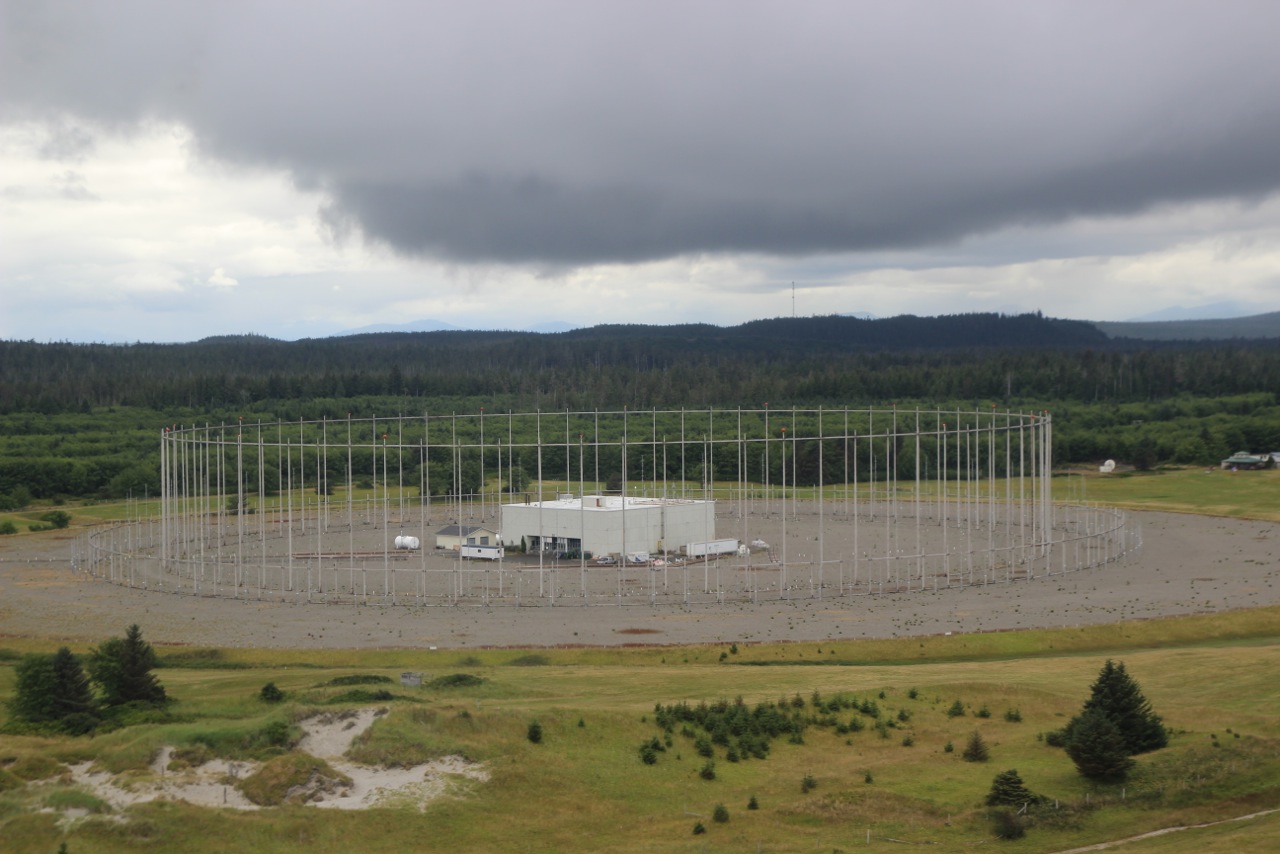 |
| Masset's AN/FRD-10 as it appeared in July 2015.
(Photo
by Sean Costello) |
CDAA technology was developed by the German navy during the early years
of World War II. The technical team leaders were Dr. Pietzner, Dr. Schelhorse,
and Dr. Wachtleter. The latter was a co-founder of the Plath Company and
later a consultant to Plath and Telefunken. Although all three men retired
in West Germany, some of their second-echelon technicians were taken to
the USSR after the war. This led to the Soviets deploying 20 CDAAs before
the United States military became interested and developed their own version
of the technology.
At Khabarovsk Kray, Russia, the Defense Ministry built a CDAA facility
code-named "Krug" which has an antenna 1 kilometer in diameter. In
Russian, krug means circle.
The original two CDAA systems were built by the Germans. The first one,
built at Joring Denmark, was destroyed following the war in accordance
with the Geneva Convention. Dr. Wachtler arranged to have a second one
built at Telefunken's expense, at Langenargen/Bodensee, for further experiments
after the war. These were the only two CDAA's ever built by the Germans.
The CDAA was also called the Wullenweber antenna. Jurgen Wullenweber
was born in Hamburg in 1488, and was a mayor of Lubeck from 1533 to 1537.
He was a legendary figure, known as a fighter against injustice and the
wealthy class (sort of a Robin Hood) and an upholder of the Protestant
Cause. He was killed in Wolfenbutiel in 1537 while on a foray to uphold
his ideals and became somewhat of a martyr. His name was used by the Germans
as the cover name for their CDAA project during WW II.
In the years following the war, the United States disassembled the CDAA
at Langenargen/Bodensee and brought it back to the University of Illinois.
Ed Hayden, a young engineer, led the reassembling of the CDAA and studied
it. Three antenna designs came out of this study:
AN/FLR-9 - used by the U.S. Air Force and Army;
AN/FRD-10 - used by the U.S. Navy
AN/FRD-13 - 'Pusher' System used primarily by the British.
FRD-10 antenna sit on sites around 40 acres and each have a two story
Ops Building about 40 square meters dead center. These antennas are
majestic in size and have been dubbed various names by the inhabitants
of nearby civilian communities. Names such as the Dinosaur Cage,
Elephant Cage, or the Turkey Cage are common. One uncoomon term was Shotgun.
With a nominal range between 150 to 5000 kilometers1, CDAA
arrays consist of two rings of HF antennae effectively covering 2-30
MHz ( the upper frequency needs conformation) and intended to be a receive-only
antenna for DF work and signal intercept.
The inner ring, for monitoring longer longer wavelength signals (2-8
MHz), is typically some 230 meters in diameter usually containing 40 folded
dipoles perhaps some 36 meters in height. The outer ring for monitoring
shorter HF wavelengths (8-30 MHz) is about 260 meters in diameter and contains
some 120 sleeve monopoles. In between each ring is a large wire screen,
supported by 80 towers. This shields antennae on one side of the array
from HF signals on the other side from crossing and creating interference.
The entire antenna site sits atop a ground screen that is 400 feet diameter2.
Each element is fed by large 75 ohm , low loss coax which is meticulously
phase matched across the antenna array before it enters the Operations
building at the center. Maintaining tolerances of less than an inch
are important. The cables then enter a series of primary antenna multicouplers
that function to distribute the RF energy from each element. One tap of
the low band multicoupler goes to a goniometer which switches the elements
electronically and provides a "chopped" version of the RF which is then
used in either sum or difference modes to resolve azimuth information.
There is a separate goniometer for the high band array. Other outputs of
the multicoupler connect to secondary multicouplers whose outputs are then
presented to the receivers. Because the goniometer was electro-mechanical
in nature, its sector switches were electrically noisy, a slight determent
to its operation. Walter Salmaniw confirms the use of the TMC CU-5069/FRD-10A
at Masset . This was a 32 port antenna multicoupler.
By means of some very elaborate electronics which connected and disconnected
antennas sequentially around the ring, the receiving "beam" was swept around
all points of the compass. If this swept beam was applied to a wide
band receiver(s) it would be safe to assume that the FRD-10 provided
a near instantaneous bearing of any signal that appeared in the radio
spectrum for even a fraction of a second. When combined with the information
from other FRD-10 sites operating in real time, a bearing could be obtained
immediately and it would be virtually impossible to hide any HF transmissions.
Stuart Morrison, K4BOV adds this narritive on CDAA technology from a
2001 e-mail..
"The largest CDAA ever built had 120 monopole elements for the 8 to
30 MHz range. Although the goniometer spun thru the monopoles at a very
high speed, only two elements were electronically coupled to the DF set
at any one instant. However, depending on the speed of the goniometer,
each monopole set could be sensed a several times a second - at that rate,
any signal observed on the DF azimuth screen would appear as a stationary
presentation. Bearings were read out to the 1/10th of one degree - pretty
damn good resolution!.
The manner in which signals arrive at the DF antenna; or any antenna
for that matter is not that predictable. Signals arrive at various angles,
and thus, the FRD-10 electronics was designed to accommodate these differences.
A good HFDF operator was always cognitive of atmospheric conditions, time
of day and wavelength/frequency considerations; so, he knew when to expect
the arrival of high angle or low angle signals. The FRD-10 antenna ring
could be phase switched between approximately 45 degree and 15 degree (some
modifiable to 30 degree) arrival paths.
Long distance low angle incoming signals would then be better treated
when the antenna phasing was set for 15 degrees. And for example, hams
operating on 75 meters at say late afternoon at distances of 100-200 miles
would be dealing with high angle signal reception and therefore the FRD-10
system would be switched to the 45 degree position to improve the signal
strength and direction finding accuracy.
As far as possible gain of such an antenna system, we examined this
for the 60, 90 and 120 monopole systems. Most of the CDAA's were not designed
to lock and hold the entire antenna ring, all 120 monopoles, phased in
any one direction; so, it took our R&D team nearly 4 days to accomplish
that - every associated coax line had to be "delay phased" and impedance
matched so that a signal from the selected direction was received precisely
at the exact moment at the signal buffer stage.
Theoretically, the 120 monopole system is capable of about 21db gain.
However, our best efforts produced a little over 19db gain Still, a tremendous
gain for any HF antenna and even many high gain VHF and UHF antenna systems.
The front-to-back ratio was far greater than anything I'd seen in any antenna,
be it Rhombic, Yagi, Log Periodic, etc"
***
Anyone who dreams of building an FRD-10 in their backyard will have extreme
difficulty. Aside from the land requirement , the US Government describes
costs of between $800,000 to $900,000 for a single example when they were
first being installed in the 1960's! (Masset's FRD-10 installation and
Operations Building cost $11 million in 1970). Details of the antenna curtain
itself are readily available in the public domain but the finer details
of the phasing and goniometer circuitry is presumed to be classified.
At Masset, the FRD-10 served in both the intercept and DF functions.
Through time domain reflectometry, segments of the antenna could be selected
and used as a receiving array -- i.e five or six monopoles acting like
a phased array.
 |
| This is the FRD-10 installation at Imperial Beach California in 1964.
Any aerial view of an FRD-10 always provides a better illustration
of the outer ring of antennas. (Photo courtesy Wullenweber/CDDA Antenna
Homepage) |
Both Gander and Massett had "X-Loop" antennae, for DF work at frequencies
below what the Wullenwebbers could handle. These were VLF loops,
electrically steerable using a goniometer.They were much larger than the
crossed loops often seen on ships.
PROJECT CLAIRNET BULLSEYE
Some documents use the terms Clarinet Bullseye or Classic
Bullseye when referring to DF sites which employed the AN/FRD-10.
Bullseye was actually a particular project name and was not a Net. It was
a follow-on to a project called Boresight, which sought to
upgrade and automate regular HFDF work. Boresight was centered around the
AN/GRD-6 DF equipment used by the USN. Most of the National Security Group
(NSG) DF stations installed the GRD-6 in the mid to late 1950's.
Project Clarinet Bullseye (full name) ran from 1 Dec 1958 to 15 April
1965. It was a period for the development and deployment of communications
methods and operations doctrine. The end date indicated when the system
was declared fully operational. For those personnel who worked on the project,
the Secretary of the USN awarded the Navy Unit Commendation for their efforts.
Due to security reasons, the Secretary could not mention any specifics
in the citation nor does the document bear a creation date. In essence
it said that "a momentous intelligence void was recognized which threatened
the security of the US. The means to obtain the necessary intelligence
was no longer available and there was no quick solution at hand. It was
the Clarinet Bullseye Task Group of NSG which ultimately provided a solution
through Project Clarinet Bullseye".
At this time, it is not clear how the the name of Clarinet was dropped
and replaced with Classic but Sam Stokes offers a theory. "During the 1980's
the U.S. Department of Defence created a whole series of DOD-wide "Permanent
First Word Assignments" called CLASSIC for the Naval Security Group. Examples
of this "Classic" word were: Classic Wizard, Classic Outboard, etc.
There were many of them".
The Classic Bullseye Project was shut down in the early to mid 1990's
when AN/FRD-10 sites started closing down.
Excerpts from the article "The FRD-10: An Endangered Species" by Bill
Robinson provides some excellent background information on the initial
deployment of the AN/FRD-10.
"In the early 1960s the U.S. Naval Security Group (NSG) began
deploying a network of large high-frequency direction-finding, circularly
disposed antenna arrays (part of the AN/FRD-10 DF system), to detect, monitor,
and plot the location of Soviet submarines and other radio emitters in
the Atlantic and Pacific oceans.
Fourteen of the huge arrays were eventually deployed by the NSG. The
locations are as follows with dates in parenthesis when HF operations ceased.
|
LOCATION
|
CEASE OPS DATE
|
COMMENTS
|
|
|
|
| Adak, Alaska |
December 1994 |
CDAA removed. Property remains under Navy control.
See note 2. |
| Edzell, Scotland |
9-30-1997 |
CDAA removed. Property returned to UK |
| Galeta Island, Panama |
3-13-1995 |
CDAA remains; abandoned. Property now under Panamanian
control . |
| Guam |
12-31-1999 |
CDAA remains unused on property of active NAVCOMTELSTA Guam. |
| Hanza, Okinawa |
June 1998 |
The Navy left Hanza in June 1998 but the site continued
operations using contractor personnel until 2006. The site was finally
shut and cleared in June 2007. The property will be returned
to the Japanese government. |
| Homestead, Florida |
6-9-1993 |
CDAA removed. Property reportedly sold to Motorola. |
| Imperial Beach, California |
9-30-1999 |
CDAA remains abandoned on property of Navy's Silver Strand Training
Complex. |
| Marietta, Washington |
March 1972 |
CDAA removed. Property reverted to Lummi Indian
Reservation. |
| Northwest, Virginia |
6-1-2001 |
CDAA removed. Property is now an annex to Naval Support Activity ,
Norfolk, VA. |
| Rota, Spain |
Late 90's |
While Rota closed manual DF operations in the late 90s, it was still
doing remote DF in June 2000. The CDAA is now removed from property of
active NAVCAMS Detachment Rota. |
| Sebana Seca, Puerto Rico |
Late 1990's |
CDAA removed. Property sold and being developed
by commercial enterprise. |
Skaggs Island,
California |
18-06-1993 |
CDAA removed. Property to be transferred to U.S.
Fish and Wildlife Service upon remediation and removal of all buildings. |
| Wahiawa, Hawaii |
4-10-1998 |
CDAA remains unused on property of active NAVCAMSPAC.
To be removed for new buildings. |
| Winter Harbor, Maine |
1998 |
NSG OPs closed Sept 2001. CDAA removed. Property officially transferred
to US National Parks Service in 2002 |
Notes for this table :
1) By late 1999 all net operations had ceased although
a few sites were remotely controlled for a very short period of time.
2) Adak (call sign: NUD) was a Dual Station that operated
in both the Eastern Pacific and Western Pacific HFDF networks therefore
the station had two sets of everything - two KWR-37s to receive FLASH messages
from the Net Controls; Two KWT-26s to report the results to the Net Controls.
Communications to and from net controls were via radioteletype. Once a
week, the Net Controls were switched to Alternate Net Controls and the
CW transmitters were brought up and the networks would be exercised
at "manual" operations - that is, Flashes and Bearing Reports would be
sent via morse code using the JOVE One Time Pads.
During WWII, the USN's presence on the island first started
when the US Navy temporarily set up the 17th Naval District Headquarters
there for Alaska and the Aleutian Islands. They had Radio Finger Printing
(RFP) and the DAJ receiving components for direction finding. During the
late '50s, the DAJ was replaced with the GRD-6 direction finding equipment
that was used through the late 1964. CDAA initial construction started
in 1962 at Clam Lagoon and HFDF operations in EASTPAC and WESTPAC narrowband
and wideband operations started around December of 1964. In November of
1966, the GRD-6 system at Zeto Point was removed.
Another two FRD-10's were built by the Canadian Forces Supplementary Radio
System; one at Gander, Newfoundland and one at Masset, British Columbia.
Both were built in the 1970-71 time frame.
The FRD-10 arrays became the backbone of the Classic Bullseye project,
a composite of the Atlantic and Pacific HFDF nets. They were supplemented
by a number of smaller, simpler CDAAs known as Pushers, including a Canadian
Pusher in Bermuda. Canada also has Pushers deployed at Leitrim, Ontario
and Alert, Nunavut.
The FRD-10s offered four major improvements over their predecessors,
the AN/GRD-6 in NSG service and the AN/GRD-501
in Canadian service:
* Transmissions could be recorded for immediate or subsequent direction
finding.
* Bearings were four times as accurate.
* Antenna gain was about four times higher than previous systems.
* The system had the ability to select desired signals and reject interfering
signals or noise.
As noted in the Supplementary Radio Activities Consolidation Plan (30
May 1966), the improvement expected as a result of deploying the FRD-10's
was a combination of more accurate and reliable fixes, producing reduced
search areas in ocean areas of prime responsibility so fresh in time, as
to enable maritime commanders to deploy their forces more economically
and with much greater prospect of making contact with the target than is
now the case."
Sam Stokes recalls some of the uses for the CDDA's. "One of them
was used to catch the burst transmissions from Soviet block submarines
sailing the Pacific4. At Imperial Beach California, that site
was used to capture information from various target countries
in order to create an electronic order of battle for US Armed Forces.
For a very short time after the station became operational, the FCC used
the facility for determining bearings for signals of interest".
The FRD-10 at Imperial Beach was the only one of the fourteen NSG antennas
which was also used for general-service ship-shore reception with NSG HFDF
on one deck and NPL ship-shore receivers on another.
Ray White reiterates a story which made the rounds in the 1970's. It
said that "a Soviet Air Force bomber traveled to the Abbotsford BC International
Air Show and sent position reports in CW back to their home base
as they flew across Canada. During this flight, the Russian KRUG network
was using the aircraft transmissions for check bearings and was reporting
the bearings in tenths of a degree. Our backplotting of these bearings
is said to have confirmed their accuracy".
David Shirlaw passes on this little story. One day, a CW message was
copied at Masset. It was from the Russians and it simply said "Merry
Christmas to CFS Massett."
Jim Frame, who served at Masset between 1988 and 1992, recalls an experiment.
"I was in charge of a little known experiment conducted at Masset
in 1992 and named Project Palantir. It involved the use of the AN/TSQ-164,
a tactical, HFDF, Single Site Locator analysis system. During the duration
of the experiment, we operated from a tent above the old Masset Ops
site 24 hours per day, 7 days per week using diesel generator power. The
system used an ionospheric sounder to map the ionosphere thus determining
the angle of radio signals being received at the site. Not only would it
render a line of bearing, but would calculate a location by itself.
By running a cable from the Operations building, across the road and up
the mountain to our cipher gear, we managed to interconnect the TSQ-164
to the world wide Classic Bullseye project, the first time it had ever
been done, at least to my knowledge."
Of the fourteen AN/FRD-10 arrays built by the U.S. Navy in the 1960's,
most lasted into the late 1990's. First built was Hanza, Japan in 1962
while last built was Imperial Beach, California in 1964. First to
be dismantled was Marietta, Washington in 1972. As more and more communications
moved up the frequency spectrum, these CDAA sites became less and less
important as satellite based equipment came to take over the missions of
these old sites. The Canadian arrays at Masset and Gander, Newfoundland
are safe for now but it's definitely the end of an era.
TRANSMITTING FACILITIES
After 1970, it was all landline communication. There were no transmitters
at the New Site. Masset's military routing indicator for unclassified and
classified traffic is RCWEOEA.
SOME KNOWN RADIO EQUIPMENT USED AT MASSET
Any mention of equipment types used at Masset would be most appreciated.
(Send to jerry.proc@sympatico.ca)
Click to enlarge
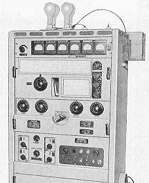 |
1950's: Canadian Marconi PV-500HM Transmitter:
Range - 3 to 19 MHz. 500 watts. Crystal or VFO control. CW or MCW. Used
for transmitting bearings to the Eastern Pacific HFDF net control station.(Image
courtesy RCN) |
 |
1950's: CNF-4 HFDF Set. The three band
set could receive from 2.7 to 25.0 MHz. (Photo by Leblanc, DND.
National Archives of Canada, photo # PA-142540) |
 |
1950's: Marconi CSR5A Receiver. A
general coverage communications receiver manufactured between 1942 and
1944. Coverage - 80 kHz to 30 MHz in six bands. By 1952, they had
fallen into general disuse in the SUPRAD system except for training and
were gone after 1955. (Photo by Jerry Proc) |
 |
1950's: Hammarlund SP-600 Receiver. Coverage:
0.54 MHz to 54 MHz, in six bands. SP600's were produced between 1950 and
1972. (Image courtesy Kurrarjong Radio Museum) |
 |
1960's: AN/GRD-501 DF SET. It was installed
around 1960 since the funding was approved in fiscal year 1958-59. (Image
courtesy RCN) |
 |
1960's: R1230/FLR wide band receiver.
Click on photo for more info. (Photo courtesy National Radio Products) |
| No photo available |
1990's: AN/TSQ-164 and also (V). This
is a tactical, HFDF, Single Site Locator System code named DRAGONFIX. The
AN nomenclature system codes it as: T=Ground transportable, S=Special types,
magnetic, Q= Special or combination types. Built by Andrew SciComm, it
is described as a HF intercept, DF and analysis system. It was used during
the Desert Shield and Desert Storm military operations. Frequency range:
1.6 to 30 MHz. Power output 125 watts. Works with a field-erected dipole
antenna 8 metres above ground. |

|
1970's: AN/UYK-3 general purpose
15 bit, transistorized computer. Click here for
additional info. |
AMATEUR RADIO
Harry Billand , VE7JH, who served at Masset recalls amateur radio operation
there. " We had our own ham station, call sign VE7TAR, and used the Drake
TR-7 line of equipment. The rig was connected to a 72 foot tower which
stood next to the gym. Our main mode of operation consisted of setting
up phone patches for the personnel stationed at CFS Alert.
 |
| Drake TR-7 transceiver type used at Masset in the 1980's. (Photo
courtesy Shadowstorm.com web page) |
STAND DOWN
In February 1994, the Department of National Defence announced that
Masset would be fitted for remote control operation and downsized.
On 4 April 1997, the station was stood down and redesignated CFS Leitrim
Detachment Masset. Masset is now under remote control from CFS Leitrim,
Ontario.
Most of the buildings at the former station have been sold to the Village
of Masset, except for a few of the PMQs (Permanent Married Quarters) and
the gym. A top floor was added to the Golf Clubhouse, the all-ranks
mess. All that remains of the "Old Site" is a deserted roadway.
Jim Troyanek who served in Masset between 1971-74, 1976-85 and 1989-90
visited the site in 2004. He says "The present DF site is relatively unchanged
from the way I remember it. I have been back several times since
I retired from there in 1990 but in June 2005, there was a fire which destroyed
a storage area which was right next to the Operations Building.
After the FRD-10 and new Operations Building was up and running, all
the previous antennas were or course torn down. Four PMQs remained
and were still in the same shape as in 1984, when they were of no
further use back then because newer PMQs were added to the downtown site.
The old, Single Quarters building continued in use as a workshop until
sometime around 1985.
I left Masset in 1985 for Kingston returning in 1989 for a few months
before I retired While gone, the old site was completely dismantled.
In fact the water tower was brought down with a big bang in early 1985.
All that remains of the Old Site (NRS Masset) are the paved roads and the
pavement in the tennis courts. The two entrances are chained off
and locked, as is the road which leads back to the bog where the antennas
were. They even had a small bore shooting range back there.
The storage building for the range still remains, in bits and pieces".
During its heyday, CFS Masset employed more than 300 military and civilian
personnel of which approximately 130 were of from the 291 Communications
Research trade. The remote operation carries on with about 30 military
personnel, none of whom are 291ers. Also gone is the Military Occupation
code 291. It was replaced with the Military Occupational Structure Identifications
codes (MOSID). They are five digit codes, and 291ers have been classified
under MOSID 00120.
In March 2014, DND issued a Request for Quotation to overhaul antennas
at various sites across Canada. These are the antennas shown for Masset.
| QTY |
MODEL |
No. of
MASTS |
MAST
HEIGHT |
TYPE OF
MAST |
MFG |
DESCRIPTION |
|
|
|
|
|
|
|
| 1 |
AN/FRD-10 |
40 (?) folded dipoles ( 2 to 8 MHz)
120 (?) sleeve monopoles (8 to 30 MHz) |
|
Wooden mast sipports
Aluminum elements |
RCA |
CDAA Array |
| 1 |
DND |
5 |
1 x 110 feet
4 x 30 feet |
Aluminum |
? |
Crossed loop |
| 1 |
? |
Many |
7 feet |
Wooden |
? |
Long wire Beverage |
| ` |
? |
2 |
80 feet |
Wooden |
? |
Grounded loop antenna |
BEVERAGE ANTENNA
The Wave Antenna, which later became known as the Beverage Antenna,
is a unidirectional antenna. It was developed by author H. H. Beverage,
Chester Rice and E. W. Kellogg of the General Electric Co., and is covered
by patents and applications. A two wire Beverage antenna is a specialized
type of long-wire antenna used primarily for low-frequency reception
It's known for its low noise, directional sensitivity, and excellent performance
over long distances.Here’s what makes it unique:
Key Features
• Bi-directional reception: Unlike a single-wire Beverage, the
2-wire version can receive signals from two opposite directions. This is
achieved by switching between the two wires, each optimized for one direction.
• Low height installation: Typically installed very close to
the ground—less than 0.05 wavelength above it—which helps reduce noise
and improve signal-to-noise ratio.
• Balanced transmission line: The two wires act as a balanced
line, requiring careful spacing and parallel alignment to maintain performance.
• Transformer matching: A transformer is used at the feedpoint
to match the antenna’s impedance to the receiver, often with values like
75, 150, or 450 ohms.
It is believed that the Beverage antenna at Masset has been in place
since no later than 1985.
In December 2021, the Department of National Defence proposed a project
which involves the clearing of some brush and fallen logs, and the installation
of a surface laid boardwalk, This was needed to ensure that Detachment
personnel could access the Beverage antenna safely in order to perform
maintenance and inspections. The Beverage Antenna covers a distance of
approximately 1 km (3,280 feet) through muskeg and brush and is located
at the end of a gravel road approximately 1.2 km south of the main detachment
facility. The terrain through which the antenna is constructed is uneven
and often very wet and muddy. Proposed activities included the clearing/trimming
brush for a narrow path parallel to the Beverage Antenna; construction
of a timber boardwalk; and placing the timber boardwalk along the cleared
path parallel to the Beverage Antenna.
On December 21, 2021 the Department of National Defence issued its Notice
of Determination and determined that the project is not likely to cause
significant adverse environmental effects.
 |
| This is a generic image of a Beverage antenna.
It is not the one which is installed at Massett. The longer of the
two Beverage antennas at Masset is 1080 meters long. Because the
ground which parallels the Massett Beverage is boggy, a wooden boardwalk
has been installed should the antenna need any maintenance..
(Photo courtesy play.fallows.ca) |
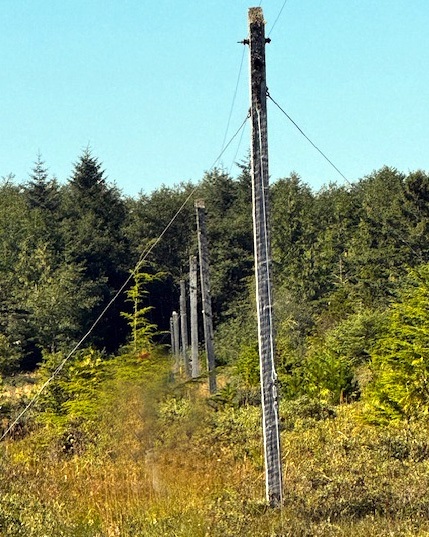 |
| Part of of the long Beverage antenna installed
at Masset. The support masts are about 15 feet in height. |
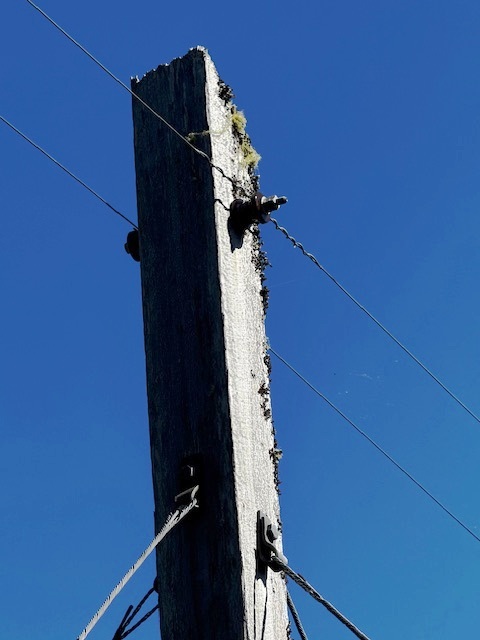 |
| This photo details the placement of the standoff
insulators and guy ware attachment points for the 2 wire Beverage
antenna. |
 |
| This image shows the location of the longer Beverage
antenna relative to the square Operations building. It was erected in the
1992-1993 time frame and its constructed as a 2 wire Beverage which makes
it bi-directional. Click on image to enlarge. (Image via Google
Earth via Bill Robinson) . |
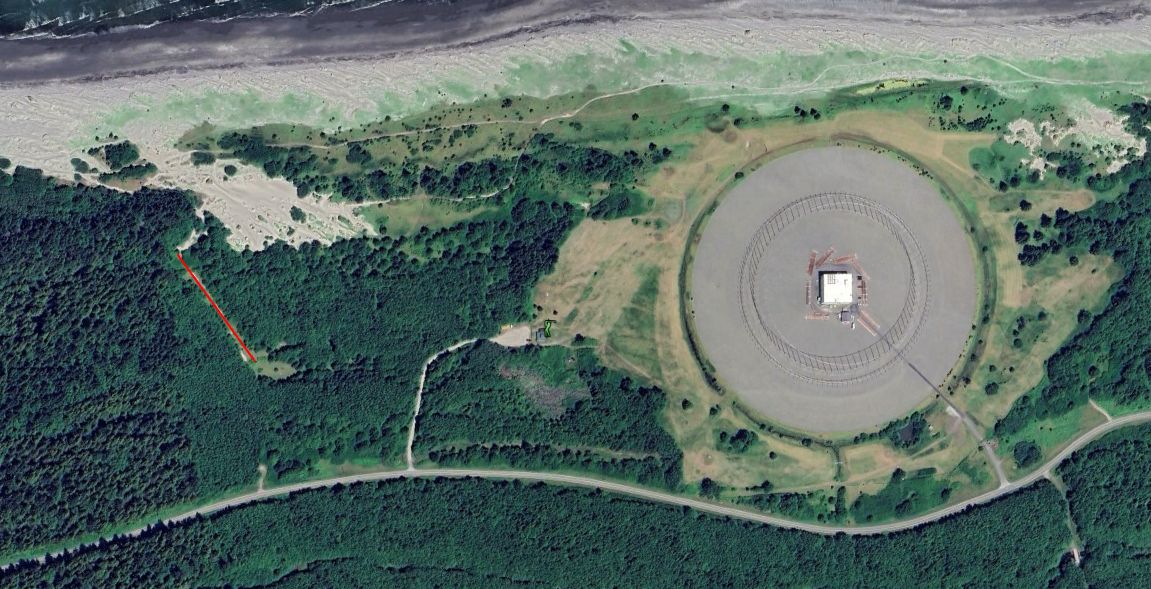 |
| Towards the left side of the photo and marked
in red , is the shorter of the two Beverage antennas installed at Masset.
It appears to be 180 metres long and oriented on a bearing of 325 degrees,
the same direction as the longer Beverage. The shorter Beverage has a fundamental
resonant frequency of 1.67 MHz. (A Google Earth image provided by Bill
Robinson) . |
 |
| Using Google Earth, it was determined that the
broadside direction of the Beverage antenna has an azimuth of 325
degrees, which as the screenshot shows, points to central Siberia. The
three tiny yellow dots on the northern Siberian coast are those of Russia's
Arctic staging bases for the Long Range Aviation force, probably among
the key targets of Canadian monitoring. Click on image to enlarge. (
Image via Google Earth via Bill Robinson) . |
STORIES
Volodya Salmanov provides two stories about Masset.
"During construction of the station, they were using using Euclid scrapers
to level the sand dunes. Apparently, they were under powered for
the job, so they had to make a run in order to fill the scoop. In
the process, one of the scrapers rolled over and killed the operator ".
"There were real problems with cows wandering through the site and damaging
the welded ground mesh with their hooves. Even today, the cows tend
to go into the bush to the south, across the road during the day, and return
at dusk to the north side onto the golf course that surrounds the FRD-10."
UPDATE FOR THE AN/FRD-10 SYSTEM
 Naval Radio Station (NRS) Masset became active on 23 February 1943 as a
HFDF intercept station and a relay station for ship-to-shore communications.
At war's end, Masset was placed into caretaker status until reactivated
in 1949 under call sign CFS.
Naval Radio Station (NRS) Masset became active on 23 February 1943 as a
HFDF intercept station and a relay station for ship-to-shore communications.
At war's end, Masset was placed into caretaker status until reactivated
in 1949 under call sign CFS.




